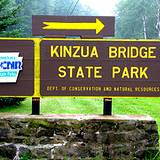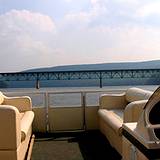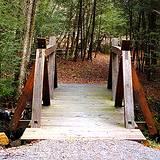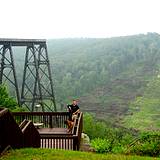|
Kinzua Bridge State Park
|
 |  |  |
Kinzua is one of the rare Pennsylvania State Parks that doesn't have camping facilities. With the beautiful scenic views, unique hiking trails and Kinzua Dam to enjoy boating, fishing and majestic waterfalls finding a camping area outside the park isn't that big of a deal.
The Allegheny National Forest surrounds Kinzua Bridge State Park. Beginning in 1987, excursion trains traveled from Kane, PA through Allegheny National Forest, stopping on Kinzua Viaduct before returning to its point of origin. For the greater part of the 20th century, freight trains loaded with coal, lumber, and oil, and excursion trains brimming with sightseers rolled across the Kinzua Viaduct, enjoying its magnificent views.
On July 21, 2003 and F1 tornado toppled 11 of the 20 towers. The remaining nine towers of the viaduct stretch high above the Kinzua Gorge, spanning generations. Today, the park features lovely picnic areas, hiking trails, and scenic overlooks.
The bridge overlook gives great views of the viaduct and the Kinzua Creek Valley. The accessible overlook is great for viewing fall foliage and the Kinsua Creek Valley. Peak viewing times are the first two weeks of October.
The picnic area has shaded picnic tables, water and a modern restroom.
About 100 acres are open to hunting, trapping and the training of dogs during established seasons. Common game species are deer, bear and turkey.
 |  |  |
Kinzua Bridge Tornado Destruction
On Monday, July 21, 2003, at approximately 3:15 p.m., and F1 tornado (wind speed 73-112 mph) struck the side of Kinzua Viaduct Eleven towers from the center of the bridge were torn from their concrete bases and thrown to the valley floor. Fortunately no one was seriously injured.
Although the bridge received periodic inspections, it was not until a February 2002 DCNR inspection that engineers decided that the structure needed a full-scale inspection. In June, DCNR barred excursions trains from the bridge. As the inspection continued, engineers found that sections of steel were rusted through. In August, the bridge was closed to all traffic, including pedestrians.
Engineers determined that high winds could create lateral pressure on the bridge. The wind hitting the bridge could shift the center of gravity, increasing the weight on one side. Such an event could send the whole bridge crashing to the bottom of Kinzua Gorge.
Beginning in February, 2003, W.M. Brode Co. of Newcomerstown, Ohio, a national leader in railroad bridge construction and repair, began working to restore Kinzua Viaduct.
Repairs continue an effort to stabilize the remaining nine towers, DCNR is now conducting feasibility, studies to determine what to do with Kinzua Bridge.
Visitors may photograph and view the bridge from the observation deck adjacent to the bridge. Two spotting scopes are on the observation deck for the close-up look at tornado damage and bridge repairs.
 |  |  |
Kinzua Bridge History
When built in 1882, Kinzua Viaduct was the highest railroad bridge in the world. It was constructed as an alternative to laying an additional eight miles of track over rough terrain along the line leading to McKean County's coal, timber and oil lands.
Build of iron, the original viaduct was 301 feet high, 2,053 feet long, and weighed 3,105,000 pounds.
By 1900, it becomes necessary to rebuild the entire structure with steel to accommodate heavier trains. That May, about 100 to 150 men working ten-hour days completed the job in 105 days. The new steel viaduct had the same measurements, but now weighed 6,715,000 pounds.
Freight traffic discontinued in June of 1959. In 1963, Governor William Scranton signed a law that created Kinzua Bridge State Park. The park officially opened in 1970. In 1977, Kinzua Viaduct received national recognition when it was placed on the National Register of Historic Civil Engineering Landmarks.
Beginning in 1987, excursion trains traveled from Kane, PA through Allegheny National Forest, stopping on Kinzua Viaduct before returning to its point of origin.
Due to unsafe conditions in and around the bridge during repairs and clean up efforts, visitors are prohibited from walking on or under the bridge, and hiking in the immediate surrounding area.
Directions and Contact Information
Kinzua Bridge State Park
Kinzua Bridge State Park is four miles north of US6 at Mt. Jewett on SR 3011
Make Reservations at:
www.visitPAparks.com
Call: 888-PA-PARKS or
For more information call: 814-956-2646
Return from Kinzua Bridge State Park to PA State Parks
Return to Pennsylvania Mountains of Attractions Home





